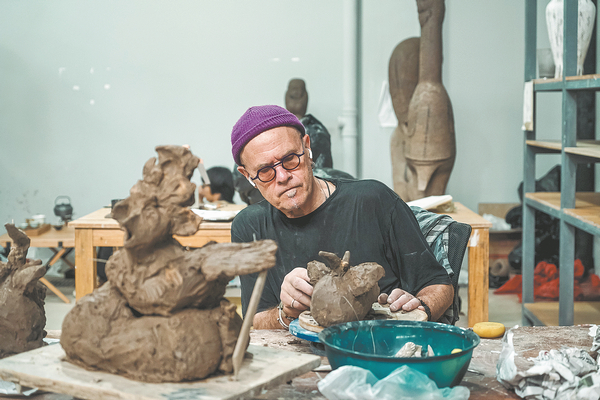

Torsten Jurell, a Swedish multimedia artist based in Sweden and China, remembers his early affinity for porcelain during his childhood.
"My father was a police officer, but he had a passion for repairing Chinese porcelain. I vividly recall seeing him seated at the kitchen table, skillfully mending broken pieces with a diamond-tipped tool," Jurell said.
"Our home was scattered with bowls and plates adorned with stunning patterns and images. My father's work allowed our not-so-wealthy family to amass an extensive collection of Chinese porcelain," the 72-year-old artist said.
Although Jurell's father never visited Jingdezhen, he imparted to his son a comprehensive understanding of China's rich history, from the Tang Dynasty (618-907) to the Song Dynasty (960-1279), and anecdotes from the reign of Emperor Kangxi of the Qing Dynasty (1644-1911).
He later learned that Sweden had engaged in porcelain trade with Jingdezhen for nearly 300 years. "Swedish porcelain trade with Jingdezhen dates back to the 18th century," he said.
China's overseas ceramic trade has a longstanding history. During the Tang Dynasty, China began exporting ceramics to Asian and African countries, followed by European countries during the Ming (1368-1644) and Qing dynasties.
In the 18th century, a significant amount of Chinese porcelain reached Sweden through the Swedish East India Company, enrapturing the Swedish populace. Swedish collectors began studying and acquiring Chinese ceramics, encompassing not only the exported porcelain of the time but also earlier pottery predating the Qing Dynasty.
In 1739, a ship bearing the same name as Jurell's hometown, Gothenburg, set sail for China, carrying Swedish black lead and cotton. It returned to Sweden laden with tea, silk and porcelain.
Motivated by the connection between his hometown and Jingdezhen, as well as his passion for ceramic art, Jurell embarked on his journey to China.
"I wanted to channel my tribute to my parents through ceramic art, although I had no prior knowledge of creating ceramics," he said.
In 2007, Jurell set foot in China for the first time and later secured a studio among local artisans at the Jingdezhen Sculpture Factory in 2011.
"I discovered that everything I needed was accessible. The realm of possibilities became endless," he said.
For artists like Ribalta and Jurell, Jingdezhen represents much more than a center for porcelain-making and ceramics. It serves as a nourishing environment for artistic growth and development.
"I've learned from a diverse array of teachers, including kiln masters and mold masters," Ribalta said. "Jingdezhen accommodates every form of artistic expression.
"In a way, I am an ambassador for Jingdezhen ceramics. I am a Jingpiao (Jingdezhen drifters, referring to nonlocals working and living in Jingdezhen), and as I stand here before you today, I represent the power of culture. It is also a testament to what my father achieved while holding Jingdezhen porcelain in his hands," said Jurell.